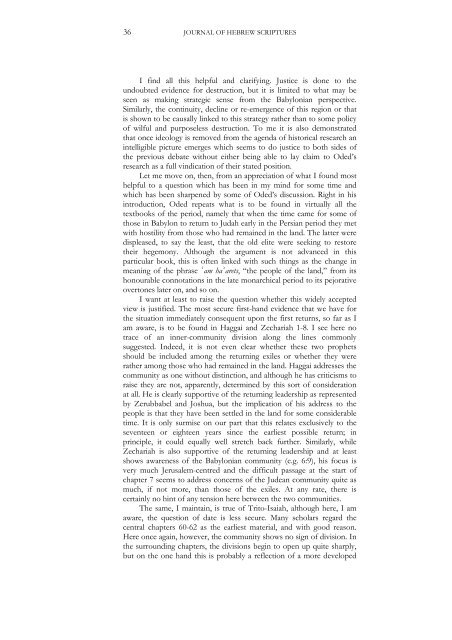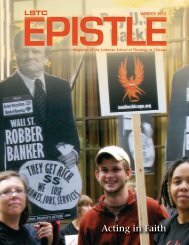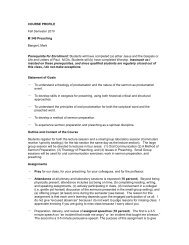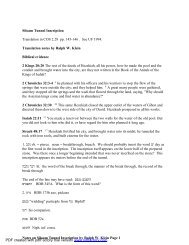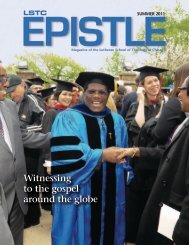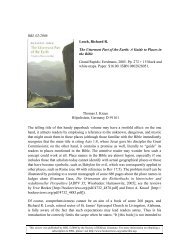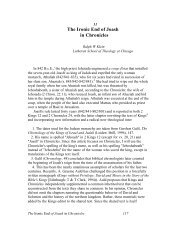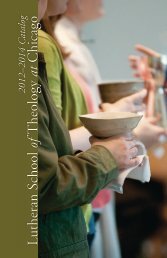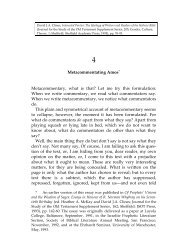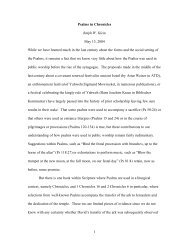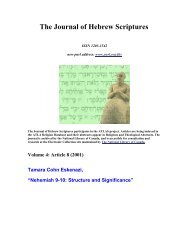Download this PDF file - University of Alberta - Journal Hosting
Download this PDF file - University of Alberta - Journal Hosting
Download this PDF file - University of Alberta - Journal Hosting
You also want an ePaper? Increase the reach of your titles
YUMPU automatically turns print PDFs into web optimized ePapers that Google loves.
36JOURNAL OF HEBREW SCRIPTURESI find all <strong>this</strong> helpful and clarifying. Justice is done to theundoubted evidence for destruction, but it is limited to what may beseen as making strategic sense from the Babylonian perspective.Similarly, the continuity, decline or re-emergence <strong>of</strong> <strong>this</strong> region or thatis shown to be causally linked to <strong>this</strong> strategy rather than to some policy<strong>of</strong> wilful and purposeless destruction. To me it is also demonstratedthat once ideology is removed from the agenda <strong>of</strong> historical research anintelligible picture emerges which seems to do justice to both sides <strong>of</strong>the previous debate without either being able to lay claim to Oded’sresearch as a full vindication <strong>of</strong> their stated position.Let me move on, then, from an appreciation <strong>of</strong> what I found mosthelpful to a question which has been in my mind for some time andwhich has been sharpened by some <strong>of</strong> Oded’s discussion. Right in hisintroduction, Oded repeats what is to be found in virtually all thetextbooks <strong>of</strong> the period, namely that when the time came for some <strong>of</strong>those in Babylon to return to Judah early in the Persian period they metwith hostility from those who had remained in the land. The latter weredispleased, to say the least, that the old elite were seeking to restoretheir hegemony. Although the argument is not advanced in <strong>this</strong>particular book, <strong>this</strong> is <strong>of</strong>ten linked with such things as the change inmeaning <strong>of</strong> the phrase (am ha)arets, “the people <strong>of</strong> the land,” from itshonourable connotations in the late monarchical period to its pejorativeovertones later on, and so on.I want at least to raise the question whether <strong>this</strong> widely acceptedview is justified. The most secure first-hand evidence that we have forthe situation immediately consequent upon the first returns, so far as Iam aware, is to be found in Haggai and Zechariah 1-8. I see here notrace <strong>of</strong> an inner-community division along the lines commonlysuggested. Indeed, it is not even clear whether these two prophetsshould be included among the returning exiles or whether they wererather among those who had remained in the land. Haggai addresses thecommunity as one without distinction, and although he has criticisms toraise they are not, apparently, determined by <strong>this</strong> sort <strong>of</strong> considerationat all. He is clearly supportive <strong>of</strong> the returning leadership as representedby Zerubbabel and Joshua, but the implication <strong>of</strong> his address to thepeople is that they have been settled in the land for some considerabletime. It is only surmise on our part that <strong>this</strong> relates exclusively to theseventeen or eighteen years since the earliest possible return; inprinciple, it could equally well stretch back further. Similarly, whileZechariah is also supportive <strong>of</strong> the returning leadership and at leastshows awareness <strong>of</strong> the Babylonian community (e.g. 6:9), his focus isvery much Jerusalem-centred and the difficult passage at the start <strong>of</strong>chapter 7 seems to address concerns <strong>of</strong> the Judean community quite asmuch, if not more, than those <strong>of</strong> the exiles. At any rate, there iscertainly no hint <strong>of</strong> any tension here between the two communities.The same, I maintain, is true <strong>of</strong> Trito-Isaiah, although here, I amaware, the question <strong>of</strong> date is less secure. Many scholars regard thecentral chapters 60-62 as the earliest material, and with good reason.Here once again, however, the community shows no sign <strong>of</strong> division. Inthe surrounding chapters, the divisions begin to open up quite sharply,but on the one hand <strong>this</strong> is probably a reflection <strong>of</strong> a more developed


